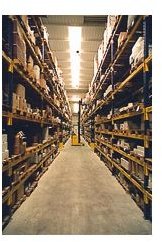The Role of Warehouses in Reverse Logistics
Great… (Eyes Roll) Here Comes Another One!
The generous return polices provided by most major retailers these days ensures that there is always a given percentage of returned products working their way back up the supply chain. Call it reverse logistics, Aftermarket Logistics, Retrogistics, or Aftermarket Supply Chain, every business owner who has to deal with returned products will generally agree it is a pain. On top of that, most managers consider returns a necessary evil, and therefore assign a very low priority to dealing with them – you should not underestimate the role of warehouses in reverse logistics. This can often result in inefficient supply chain practices, such as ordering new inventory while as-new returned products are sitting in the warehouse dock.
What Happens When You Don’t Use Them? (Gasp!)
Establishing an efficient way of dealing with reverse logistics can become a competitive advantage. Your suppliers would not take you seriously if you dressed inappropriately for meetings, nor will they if you deliver returned items two months late. All too often reverse logistics are piled on top of regular supply chain warehouses. The returns section can become a tangled mess of SKUs, with defective and “good as new” products becoming hopelessly entangled. This is usually the case when it is considered a low priority. Yet the lack of a well thought out reverse logistics system can crush an organization. For example, the 90’s era online store Value America – not exactly a model of ideal corporate governance in any area – did not have a functioning reverse-logistics system of any kind. Employees were just as likely to walk home with a returned computer as it was likely to be returned to the manufacturer. How did things get this bad? Well, in Value America’s case, they were shipping direct from distributors, so they had no warehousing of any kind.
There are two choices available for any major company expecting a steady volume of returns. The first, it to establish an in-house reverse logistics system, or outsource the task to a third-party Reverse Logistics warehouse. The difference in a firm’s operation structure would be considerable depending on which avenue the management chooses to follow; the first option requires staff and technology to move both ways, while the second allows the company to focus exclusively on getting products to market.
How to Build Reverse-Gear Into a Supply Chain
The in-house option can be applied differently, according to the size of the organization, as well as the nature of the business. Companies dealing in only a small variety of bulk commodities like iron ore, crude oil, or lumber would have a relatively easy time incorporating returned orders back into the supply chain, without the need for reverse-logistics specialists. Yet most retail operations have dozens of SKU’s and multiple varieties of every product. To avoid the returns section becoming a tangled web, multiple SKU companies that handle reverse logistics in-house must have specialized staff who know how to make sense of the paperwork, and know how to get the product back into circulation (or back to the manufacturer if it is defective).
If this sounds expensive, that’s because it can rapidly become so. The process of getting a still sell-able product back into the supply chain can require paperwork, tedious manual data entry into the digital tracking system, and repackaging. Despite the cost, specialized reverse logistics is critical, as in the modern age many products have very short production runs, so time spent sitting in the returns warehouse is time lost on the store shelf. A product that doesn’t move during the production window will eventually have to be moved through the ‘‘clearance’’ section, at little or no profit.
Let Someone Else Push The Stone up the Hill!
A solution that does not require training and maintenance of dedicated staff is to outsource the reverse logistics process to a specialized provider. This has the advantage, especially for new companies, that the in-house supply chain staff need only look in one direction towards the sales floor. Third party reverse logistics suppliers also have an economy of scale that all but the largest retailers lack. Such firms are generally much better at getting defective items back to the manufacturer efficiently because, as most retailers have many suppliers in common, they will ship perhaps 20 retailers’ defective products back in a single shipment.
Getting products back into the forward supply chain is greatly eased by the fact that sales floor quality goods are simply shipped back to the firm’s warehouse and entered into the ERP or digital tracking system, just the same as a shipment from the factory would. Having in-house warehouses ship back defective items returned in dribs and drabs can add weeks to the replacement time of each unit.
Choose Your Path, Young Skywalker
Clearly the role of warehouses in reverse logistics is one that is often over-looked and that can cost everybody. While it is a question of preference which option to choose in dealing with reverse logistics, new firms will benefit greatly from outsourcing the process – unless they only deal in a very small variety of undifferentiated products. Companies will then be able to perfect the outward bound supply chain and avoid having it clogged-up with unsellable products that nobody knows what to do with!
References
-
Photo taken by Vasco Neves Dias/wikimedia
This photo was released into the public domian.
